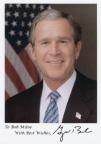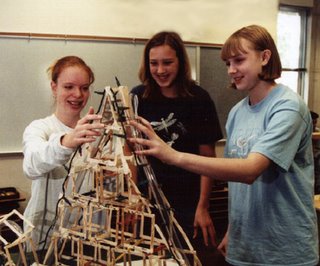
February 4th, 2006
Well, coming down from meeting the most powerful person in the world took a couple of days. Now, I would like to share with you, my partners in education, some of last week’s events and their importance to our efforts here in the academy, across the district and the state of New Mexico.
I am very proud of our success at creating the opportunity for Rio Rancho High School students to meet the President of the United States. Regardless of your personal opinion of the President, his personality, his agenda, and policies you will have to admit that meeting the President is a once in a life time event for most people in the world. Russ Fisher-Ives provided Washington with Nicole Lopez, an Engineering and Design Academy member’s, contact information. Washington called me late Thursday afternoon, Feb 2nd for a couple more students that could visit Friday morning with President Bush for 30 minute before the broadcasting of what most people saw on that morning from Intel Rio Rancho, building RR 7. Fellow International Science and Engineering competitor Bennet Grill got the call on his cell phone while in his TVI class that Thursday evening. Christian Free, a RRHS researcher on ecological and political issues, got a similar call that evening at home. I must say, they must have thought if very cool to get a call with the area code of 202. I know that I did. All three of these outstanding RRHS students got the opportunity of a lifetime, to meet the President of the United States. They visited for about 30 to 40 minutes in a briefing room filled individuals like the governor of New Mexico, the state’s Federal Senators/Representatives, State Senators/Representatives, industry and state educational leaders. But the president visited with the six panel participants, one being Nicole Lopez, Bennet and Christian. I couldn’t be more proud of being a part of providing this opportunity for these special RRHS students. There are so many other RRHS stuenents just as worthy and special as these three to meet the President, but tough and quick decisions had to be made. I want to thank RRHS teachers Jennifer Miyahiro, Teresa Walker and Rob Keeney for providing input to those tough choices. I think we did pretty well. These students represented our school and the Student Research EXPO system found in RRPS pretty darn well.
After the 55 minute round table visit, aired world wide over Intel Web Cams, I was fortunate enough to accompany Nicole’s family and Rio Rancho Mid-High teacher and Nicole’s mentor Terri-Lynn Vigil to a waiting area for more Presidential visiting and photo op. While waiting for the President to make his way back to us, I took the opportunity to visit in depth with Craig Barrett, the CEO of Intel. While he was expressing his admiration of Nicole and congratulations to Nicole’s mom and Terry-Lynn, I took the opportunity to express the following. The educational system that the educators at RRHS have developed is to be credited with the development of Nicole and students like her. Nicole was able to tell her story because of the support of her mom, the equipping found from her mentor and the system that supported her asking questions in her passion area. Hundreds of Rio Rancho students every year answer questions they are asking in areas that they have interest in. These aren’t topics of their parent’s interest or their teacher’s interest but their own. They learn how to scientifically inquire and make conclusions from their data. In short, they become independent critical thinkers. This is a skill that our 21st century desperately needs to be developed in a larger percentage of the population. Mr. Barrett heard from me that the hard work of many educators at RRHS is responsible for establishing such an educational system to help find the “Nicoles” in our classrooms. He was proud that Intel was involved in the development of this research system.
When President Bush approached our small group I met him part way, offered my hand and said, “Hello Mr. President. I am Paul Stephenson the Academy Head of Nicole’s Engineering and Design Academy at Rio Rancho High School.” I discovered from the first lady that her father was a fellow graduate of my alma mater Texas Tech University. He was one of the first graduating classes. We shared other small talk talk, but the President also heard how if we really want to “Leave No Child Behind” there are many powerful strategies to accomplish this. We need to develop good test takers, but we also need to develop critical thinkers. Our system of Student Research engages students into their own passions and demonstrates how the students can use their skills studied in the core content to answer questions in they have about those passions. This is how we truly “Leave No Child Behind”. Transform public education institutions into learning environments that actively engages students with their passions and equips them to answer questions with a trustworthy method. At RRPS we have a system that is developing critical thinking skills in a large percentage of the student population. Intel has been a terrific partner in this effort, however, we are taking this systemic culture change to public education statewide and funding is needed. But as the University of New Mexico and New Mexico State University have both publicly professed, the largest common denominator in students that succeed at the university level is the element of involvement in research at the secondary level. He listened and seemed to be very impressed with the strategy that helped uncover the likes of Nicole Lopez in a public school setting. My hope is that we benefit from some of the billions of dollars that he is attempting to convince congress and the senate to pass toward educational reform leaving no child behind.
Paul Stephenson
Academy Head
Engineering and Design AcademyRio Rancho High School







